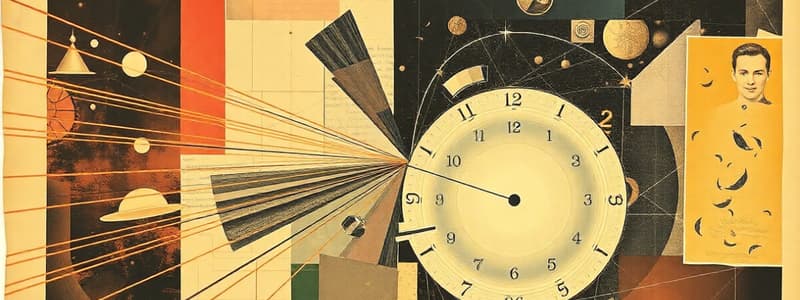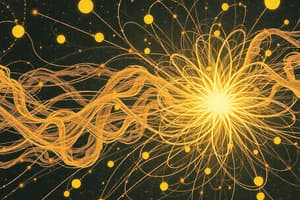Podcast
Questions and Answers
Why does increasing the time it takes to apply a force result in a lesser impact, according to the impulse-momentum theorem?
Why does increasing the time it takes to apply a force result in a lesser impact, according to the impulse-momentum theorem?
- Because the force required to produce the same impulse is smaller. (correct)
- Because the change in momentum is greater.
- Because the velocity of the object increases.
- Because the mass of the object increases.
In a perfectly inelastic collision, what happens to the objects involved after they collide?
In a perfectly inelastic collision, what happens to the objects involved after they collide?
- They bounce off each other with the same initial velocities.
- One object comes to a complete stop, and the other moves.
- They stick together and move with a common velocity. (correct)
- They move separately with different velocities.
A stationary object is subjected to a force that causes it to move. Which of the following is true regarding the work done on the object?
A stationary object is subjected to a force that causes it to move. Which of the following is true regarding the work done on the object?
- Work is always zero, regardless of the force or displacement.
- Work can only be negative.
- Work is done if the force has a component parallel to the displacement. (correct)
- Work is done only if the force is perpendicular to the displacement.
A heat engine operates between a hot reservoir and a cold reservoir. According to the laws of thermodynamics, which of the following statements is true?
A heat engine operates between a hot reservoir and a cold reservoir. According to the laws of thermodynamics, which of the following statements is true?
What distinguishes a permanent magnet from a temporary magnet?
What distinguishes a permanent magnet from a temporary magnet?
How does the arrangement of electron spins differ in magnetized versus unmagnetized materials?
How does the arrangement of electron spins differ in magnetized versus unmagnetized materials?
Which of the following is a characteristic of current electricity?
Which of the following is a characteristic of current electricity?
During projectile motion, what remains constant in the horizontal component, assuming negligible air resistance?
During projectile motion, what remains constant in the horizontal component, assuming negligible air resistance?
A soccer ball is kicked at an angle into the air. Which of the following describes how gravity affects its vertical motion?
A soccer ball is kicked at an angle into the air. Which of the following describes how gravity affects its vertical motion?
What energy transformation occurs in a heat engine?
What energy transformation occurs in a heat engine?
What is the significance of the Earth's magnetic field?
What is the significance of the Earth's magnetic field?
A roller coaster car is at the top of a hill. As it rolls down, which of the following energy transformations primarily occurs?
A roller coaster car is at the top of a hill. As it rolls down, which of the following energy transformations primarily occurs?
A positively charged balloon sticks to a wall. What type of electricity is demonstrated in this scenario?
A positively charged balloon sticks to a wall. What type of electricity is demonstrated in this scenario?
Why is kinetic energy directly related to the velocity of an object?
Why is kinetic energy directly related to the velocity of an object?
How do transformers assist in delivering electricity over long distances?
How do transformers assist in delivering electricity over long distances?
A car accelerates from rest. What happens to its momentum?
A car accelerates from rest. What happens to its momentum?
What is the relationship between potential energy and height?
What is the relationship between potential energy and height?
According to the law of conservation of momentum, what must be true of the total momentum in a closed system?
According to the law of conservation of momentum, what must be true of the total momentum in a closed system?
How is impulse related to force and time?
How is impulse related to force and time?
How does placing a magnet close to a paperclip exhibit transmission in properties?
How does placing a magnet close to a paperclip exhibit transmission in properties?
Flashcards
Momentum
Momentum
Force that resists changes in motion; defined as 'Inertia in Motion'.
Impulse
Impulse
Force applied over a period to change an object's momentum.
Impulse-Momentum Theorem
Impulse-Momentum Theorem
Impulse equals the change in momentum necessary to stop/start an object.
Conservation of Momentum
Conservation of Momentum
Signup and view all the flashcards
Elastic Collision
Elastic Collision
Signup and view all the flashcards
Inelastic Collision
Inelastic Collision
Signup and view all the flashcards
Perfectly Inelastic Collision
Perfectly Inelastic Collision
Signup and view all the flashcards
Work
Work
Signup and view all the flashcards
Energy
Energy
Signup and view all the flashcards
Potential Energy
Potential Energy
Signup and view all the flashcards
Gravitational Potential Energy (GPE)
Gravitational Potential Energy (GPE)
Signup and view all the flashcards
Elastic Potential Energy (EPE)
Elastic Potential Energy (EPE)
Signup and view all the flashcards
Chemical Potential Energy (CPE)
Chemical Potential Energy (CPE)
Signup and view all the flashcards
Kinetic Energy
Kinetic Energy
Signup and view all the flashcards
Mechanical Energy
Mechanical Energy
Signup and view all the flashcards
Heat Engine
Heat Engine
Signup and view all the flashcards
Electric current
Electric current
Signup and view all the flashcards
Projectile
Projectile
Signup and view all the flashcards
Projectile Motion
Projectile Motion
Signup and view all the flashcards
Magnetism
Magnetism
Signup and view all the flashcards
Study Notes
Impulse and Momentum
- Momentum measures how hard it is to stop a moving object, it is a vector quantity
- Momentum is also known as "Inertia in Motion"
- Greater mass results in greater momentum
- Greater time results in greater momentum
- Momentum Formula: P = mv, where P is momentum, m is mass, and v is velocity
- Momentum Unit: kg m/s
- Impulse is the force applied over time to stop an object and is a vector quantity
- Impulse Formula: J = Ft, where J is impulse, F is force, and t is time
- Impulse Unit: N.s
- The Impulse-Momentum Theorem states that impulse equals the change in momentum needed to stop an object
- Applying a force for a longer time results in less impact
- Applying a force for a shorter time results in greater impact
- Impulse-Momentum Theorem Formula: Ft = mv
- The Seat Belts Use Act of 1999 (Republic Act No. 8750) mandates seatbelt use for drivers and passengers
Key equations
- Ft = mv is the impulse-momentum theorem
- m = Ft/v calculates mass
- t = mv/F calculates time
- v = Ft/m calculates velocity
- F = mv/t calculates force
Conservation of Momentum
- States that the total momentum in a system of interacting objects remains constant if there are no external forces acting on it
- Total momentum remains the same before and after an interaction
- Two skaters push each other, with one moving forward (positive momentum) and the other backward (negative momentum), the total momentum stays the same
Types of Collisions
- Elastic Collision: Objects lose no energy, deformation is fully restored, and they move separately with different velocities, adhering to the formula m1v1i + m2v2i = m1v1f + m2v2f
- Inelastic Collision: Energy loss and deformation may be permanent, objects move in the same direction with different final velocities, following the formula m1v1i + m2v2i = m1v1f + m2v2f
- Perfectly Inelastic Collision: Two objects stick together and move with the same velocity after colliding, becoming one mass, as described by the formula m1v1i + m2v2i = (m1 + m2) vf
Work
- Work is done when a force causes an object to move
- Work Formula is W = Fd when force and distance are parallel
- Work Formula is W = Fdcosθ when force and distance aren't parallel
- Work Unit is N.m or J
Energy
- Energy is the ability to do work
- Energy can be potential or kinetic
- Potential energy includes gravitational, elastic, and chemical forms
- Kinetic energy is the energy of motion
- Potential energy is stored energy
- Gravitational Potential Energy (GPE) is due to an object's position
- GPE/PE = mgh, where m is mass, g is gravity, and h is height
- Elastic Potential Energy (EPE) relates to compression or expansion
- EPE = (1/2) kx², where k is the spring constant and x is the displacement
- Chemical Potential Energy (CPE) is stored in chemical bonds
- Greater height means more potential energy
- Greater mass means more potential energy
- Kinetic Energy is energy due to motion
- Any moving matter has Kinetic Energy
- KE = (1/2) mv², where m is mass and v is velocity
- Faster objects have more kinetic energy
- More massive objects have more kinetic energy
- Mechanical Energy is due to motion or position
- Mechanical Energy can be kinetic or potential
- ME = PE + KE
Thermodynamics
- James Prescott Joules experimentally determined the mechanical work needed to produce heat in 1945
- Heat can do work
- Heat Engines convert heat energy into work
- Internal Combustion Engines burns fuel inside the engine, e.g., Gasoline and Diesel engines
- External Combustion Engines burn fuel outside the engine, e.g., Steam engines
Laws of Thermodynamics
- Part of the heat transferred to an object does work, the rest changes its internal energy
- Internal Energy is the sum of potential energy in chemical bonds and kinetic energy of molecules
- A heat engine can only convert a limited amount of heat to work
- The Kelvin-Planck statement indicates that no heat engine is 100% efficient
- The Clausius statement says heat flows naturally from hot to cold objects
- The Entropy statement defines entropy as a measure of thermodynamic disorder
- In a reversible process, total entropy remains constant
- In an irreversible process, the universe's total entropy increases
- It is impossible to lower the temperature to 0 K (Kelvin), and ideal efficiency cannot reach 100%
- Ideal Efficiency refers to the efficiency of an ideal heat engine or Carnot Engine
Magnetism
- Is the force of attraction or repulsion due to the arrangement of electrons
- Magnetic forces are strongest at the poles
- Magnets have North and South poles
- Like poles repel, unlike poles attract
- In Unmagnetized materials, spins are unarranged and in opposite directions
- In Magnetized materials, spins are arranged in the same direction
Types of Magnets
- Natural magnets are lodestones, a type of iron ore
- Artificial magnets have artificially produced magnetic properties, such as iron, cobalt, nickel, steel
- Temporary magnets lose their properties easily, e.g., soft iron
- Permanent magnets retain their properties longer, e.g., steel
- Electromagnets produce magnetic effects with electric current, a coil of wire carrying current acts as an electromagnet
Molecular Theory of Magnetism
- Breaking a magnet results in two complete magnets
- Individual molecules act as tiny molecular magnets
- Magnetic properties arise from electron rotation
- In unmagnetized materials, molecular magnets are haphazard and neutralize - losing magnetic properties
Properties of Magnets
- Magnets align in North-South directions
- Like poles repel, unlike poles attract
- Magnetic Field: the area around a magnet where magnetic forces are apparent, flowing from north to south
- The Earth generates its own magnetic field, deflecting solar winds
- Magnets attract magnetizable materials
- Magnets transmit properties through contact or induction
Electricity
- Electricity is the movement of electrons from the outer shell of atoms (valence electrons)
- All matter is made of molecules, which are made of atoms
Types of Electricity
- Static electricity is created by rubbing two materials together, creating charged materials
- Current electricity is the flow of electric charge
- A circuit requires a closed loop for current to flow
- Electrons can only move through the circuit if it's closed
- A switch is used to open or close the circuit
Electricity in Homes
- When turned on, electrons flow and vice versa
- Current measures the rate of electron flow in Amperes
- Power plants generate electricity
- Turbines are turned by burning coal, wind, or moving water
- Generators use large magnets spinning within copper wire coils
- Moving magnets cause electrons to move within the wire, creating electricity
- A step-up transformer increases the pressure to about 756,000 volts for long-distance travel
- Substation transformers lower the pressure to 2000-13000 volts
- Pole transformers further reduce voltage to 120-240 volts
- A meter box is where electricity reaches the home
Projectile Motion
- Projectiles are objects projected and move due to inertia
- Galileo Galilei described projectile motion with horizontal and vertical components
- Horizontal Velocity is constant
- The projectile covers equal displacements in equal time
- Gravity doesn't work to increase or decrease velocity
- Vertical Velocity varies in magnitude and direction
- The projectile does not cover equal displacement in equal time
- Projectile Moves Up, magnitude decreases, direction is upward
- Projectile Moves Down, magnitude increases, direction is downward
- The components produce a parabolic trajectory/path
- Horizontally Launched Projectiles have no upward trajectory or initial vertical velocity
- Vertically Launched Projectiles have initial velocity with two components that operate independently
- Upward velocity undergoes constant downward acceleration
- Horizontal motion is constant
Studying That Suits You
Use AI to generate personalized quizzes and flashcards to suit your learning preferences.




